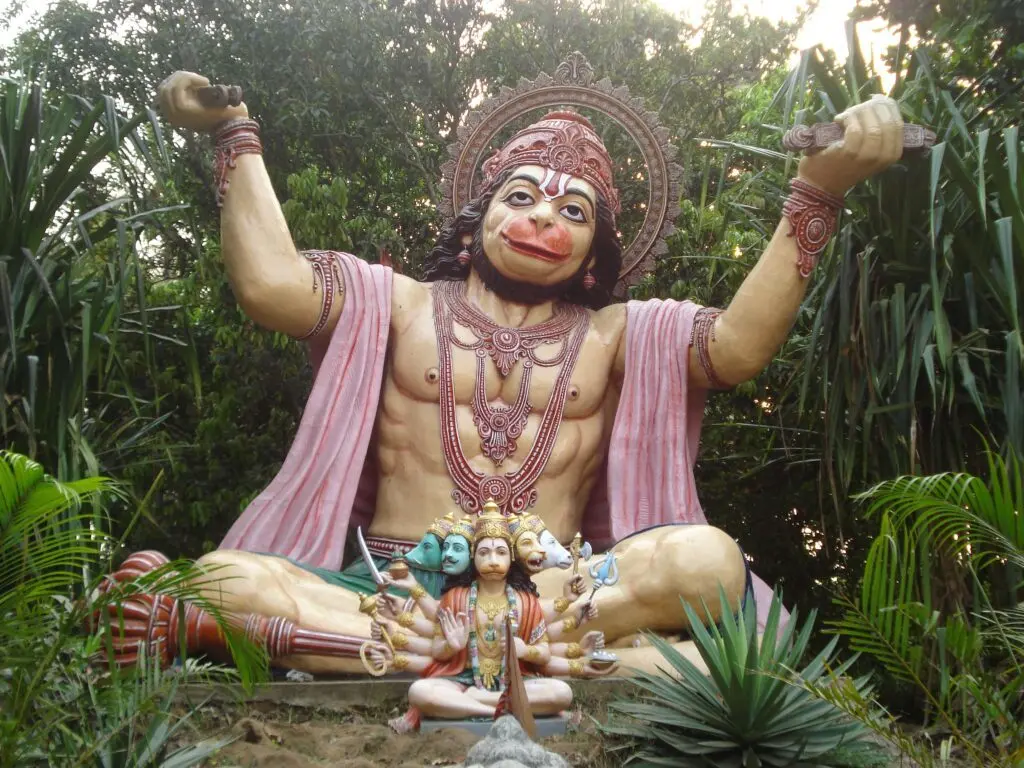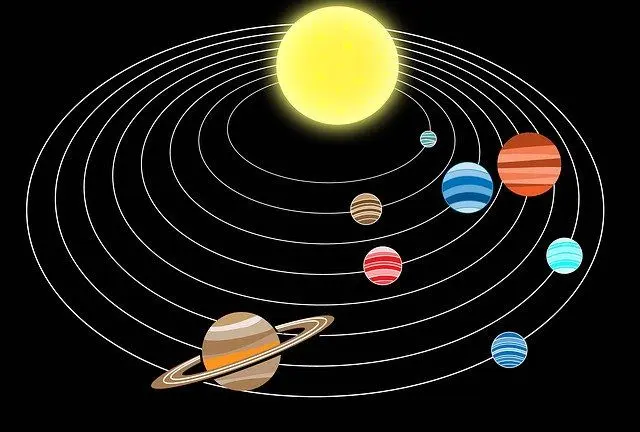
Many Hindus claim that the Hanuman Chalisa correctly calculated the distance between the Sun and the Earth before modern science while some people are calling it pseudoscience. What are the facts? Is there really any science in the Hanuman Chalisa or is it just a hoax? Let’s try to find out.
What is the Hanuman Chalisa?
The Hanuman Chalisa is a stotra (devotional prayer or hymn) addressed to Lord Hanuman who is one of the most popular Hindu gods. This stotra was written by Goswami Tulsidas in the 16th century, and is one of the most popular devotional prayers. There are 40 verses in the Hanuman Chalisa excluding the Dohas at the beginning and at the end.
What is the verse that predicts the distance between the Sun and the Earth?
Some Hindus believe that the 18th verse correctly calculates the distance between the Sun and the Earth. That verse is as follows:
जुग सहस्त्र योजन पर भानु |
लील्यो ताहि मधुर फल जानू॥ १८ ॥
juga sahasra jojana par bhānū।
līlyo tāhi madhura phala jānū॥ 18 ॥
What is the meaning of this verse?
You dashed upon the Sun, which is one yuga thousand yojanas away, thinking it to be a sweet fruit.
What is the story behind the verse?
According to the epic Ramayana, Lord Hanuman is a son of Vayu (god of air). Therefore, he possesses many superpowers. Flying in the air like Superman is one of his powers. On one morning in his childhood, he was very hungry. He saw the rising red Sun and mistook it as a fruit and jumped toward it. But considering the consequences, gods interfered and stopped him from eating the Sun.
What is a yuga and how many years are in it?
In Hinduism a yuga is an unit of time that consists of four sub-yugas viz. Satya Yuga, Treta Yuga, Dvapara Yuga, and Kali Yuga.
Since ancient times, Hindus have believed that time on different planets is different (as shown in the Hollywood movies). Therefore, a divine year (a year of gods) is different than that of a solar year. A divine year equals 360 solar years.
According to Puranas:
1. A Satya Yuga lasts 17,28,000 solar years (4800 divine years).
2. A Treta Yuga lasts 12,96,000 solar years (3600 divine years).
3. A Dvapara Yuga lasts 8,64,000 solar years (2400 divine years).
4. A Kali Yuga lasts 4,32,000 solar years (1200 divine years).
Therefore, one yuga consists of 12,000 divine years.
Calculating the distance between the Sun and the Earth:
Yojana is a unit of distance which roughly equals 8 miles as per Wikipedia.
Also if you search on Google, the answer is 1 yojana = 8 miles.
Therefore, “one yuga thousand yojanas” should equal:
12000 * 1000 * 8 = 96,000,000 miles.
i.e., 96,000,000 * 1.6 = 153,600,000 km.

According to NASA, the distance between the Earth and the Sun is:
1. 152,600,000 km (when the Sun is farthest from the Earth).
2. 147,500,000 km (when the Sun is closest to the Earth).
3. 150,050,000 km (average distance between the Sun and the Earth).
If we consider the farthest distance, both the results are quite close.
Hence, it is believed that the Hanuman Chalisa accurately calculates the distance between the Earth and the Sun.
What is the controversy?
The people that are opposing this notion give the following reasons:
A. Hanuman Chalisa is a devotional prayer and not a science book:
It is not written anywhere that devotional prayers or books should not contain scientific information. If you read Puranas that are religious books, there are mentions of sun’s as well as moon’s diameters (Linga Purana Ch. 57 – 10).
Therefore, this argument is invalid.
B. Meaning of the verse “Jug Sahastra Yojan Par Bhanu, Lilyo Taahi Madhur Phal Jaanu”:
Alternative translations:
1. On your own you dashed upon the Sun, which is at a fabulous distance of thousands of miles, thinking it to be a sweet luscious fruit.
Here the distance between the Sun and the Earth is mentioned as thousands of miles, but the translator has not considered the word Yuga.
2. The Sun that is so many yojanas away that it would take thousand yugas to reach.
If the poet wanted to say thousand yugas, the verse would have been “Sahastra Jug Yojan Par Bhanu” and not “Jug Sahastra Yojan Par Bhanu”. The word Jug here is used for two words “Sahastra Yojan”.
3. Another translation means “the Sun that is 2000 yojanas away”. There is no mention of number 2 in the verse. Hence, this translation is also wrong.
Therefore we can say that there is no problem with translation part of the verse. Also the translation that we used to calculate the distance between the Sun and the Earth is mentioned on Wikipedia. Therefore it can be considered authoritative than others.
C. Yukthibhasha, an astronomical manuscript that might have been written around the time of Saint Tulsidas’ birth got the distance to the sun wrong.
If other person got something wrong, it doesn’t mean that Saint Tulsidas also had to be wrong. I don’t think Saint Tulsidas might have even heard about this book.
D. How many years are there in a yuga?
While calculating the distance between the Sun and the Earth, one yuga is considered equal to 12,000 divine years but in a yuga, there are 4,320,000 human years. Then why are divine years used?
This is because Lord Hanuman is a god and not a human. Hence for a divine being, divine years are used.
E. One yojana means how many miles/km?
In ancient times the value of yojana differed from time to time and region to region. Many astronomers have used different values of yojana. One yojana can equal anything from 5 to 9 miles. Then why should we assume one yojana equals 8 miles?
This is because Saint Tulsidas was a great devotee of Lord Rama and a Vaishnavite. According to Vishnu Purana, one yojana equals 8 miles. Also a 14th century mathematician Paramesvara defined yojana to be about 13 km (8 miles). Therefore it is highly possible that he used the value of yojana from Vishnu Purana.
F. Who was Saint Tulsidas, and how could he possibly know the distance between the Sun and the Earth?
Goswami Tulsidas was a great devotee of Lord Rama and he wrote a book called Ramcharitmanas which is very popular among Hindus, especially in North India. In this book, Saint Tulsidas retold the story of the Ramayana in Awadhi language. He is considered one of the best poets in Hindi.
He is believed to be a reincarnation of Valmiki, the great sage who wrote the Ramayana. In Bhavishyottar Purana, Lord Shiva tells the goddess Parvati that Valmiki will reincarnate in Kali Yuga as Tulsidas and write the Ramayana in a vernacular language (Bhavishyottar Purana, Pratisarga Parva 4.20).
Saint Tulsidas hinted at several places in his work that he met Lord Rama and Lord Hanuman. Considering a saint of Tulsidas’ caliber, it is hard to believe that he would lie.
If you believe the legends, he was a very powerful saint and had some super powers.
Therefore we can’t rule out that he knew the distance between the Sun and the Earth.
G. There is no science in Hinduism.
If there is no science in Hinduism at all, then how can Hanuman Chalisa contain this scientific fact?
1. In this article when we calculated how many years are there in a yuga, we saw that one divine year equals 360 human years. It means Hindus already knew that time is different on different planets. Modern science came to know this in the 20th century.
2. Hindus knew that there were nine planets in our solar system, although they couldn’t identify all the names correctly (five names were correct). But why did they say that there were nine and not eight or ten planets?
There are many such examples.
But there are many errors also.
E.g. Linga Purana says the diameter of the Sun is 9000 yojanas (72,000 miles) which is incorrect. The diameter of the sun is 865,370 miles.
There are many such examples also.
Therefore saying that Hindu scriptures don’t contain any science at all is invalid. There is certainly some science in Hinduism, although not everything mentioned in Hindu scriptures is correct.
H. Calculations are not precise.
While calculating the distance between the Sun and the Earth, precision is overlooked at some places.
1. In the above calculation, first miles is used and then the outcome is converted into kilometers. If we use the unit kilometer at the first instance, then the outcome is:
12000 * 1000 * 12.87 = 154,440,000 km.
This answer is less accurate than the one we first calculated.
2. In the first answer, when we convert miles into kilometer, the conversion factor is taken as 1.8 but actually, 1 mile equals 1.60934 km.
If we multiply 96,000,000 by 1.60934, then answer is 154496640.
3. The first calculation is close to accurate only if we consider the farthest distance of the Sun from the Earth. If we consider average or the closest distance, the accuracy further decreases.
1. Farthest from the earth: 153,600,000 – 152,600,000 = 1,000,000.
2. The sun is closest from the earth: 153,600,000 – 147,500,000 = 6,100,000.
3. Average distance between the Sun and the Earth: 153,600,000 – 150,050,000 = 3,550,000.
Conclusion:
Therefore from above calculations, we can conclude that the Hanuman Chalisa roughly calculates the distance between the Earth and the Sun correctly and not accurately.
Considering that Saint Tulsidas was not an astronomer and it is mentioned in devotional prayer, it is a great achievement, but if you want to send a spaceship to the Sun, then you can’t rely on these figures.
References:
1. https://en.wikipedia.org/wiki/Hanuman_Chalisa
2. https://en.wikipedia.org/wiki/Yojana
3. https://en.wikipedia.org/wiki/Yuga
I was talking with my girlfriend about this, and how shocked I am knowing that an ancient script or poet has that level of knowledge. Then she told me it could be possible that by passing time, they may have changed Hanumanchallisha or its written words to give it a huge meaning.
So I want to know, do we have the real version of that exact text of hanuman Chalisa? … Actually I also want to believe in those lines with full knowledge, so that I can give answers to people with queries.